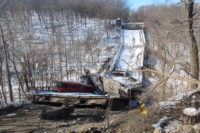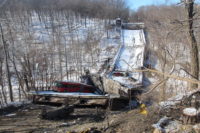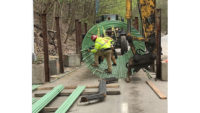The National Transportation Safety Board has launched an in-depth investigation of the Jan. 28 collapse of Fern Hollow Bridge in Pittsburgh, beginning with what is expected to be multiple days at the site in Frick Park.
The focus then will shift off-site, as investigators study damaged components. Team members also will pore over bridge records, including past inspections of the structure.
“We are going to put this bridge under a microscope,” NTSB Chair Jennifer Homendy told reporters in a briefing at a hotel in Pittsburgh on Jan. 29.
Homendy, who has been on the safety board since 2018 and was sworn in as its chair last Aug. 13, also noted that the investigation will be “lengthy.” She said the final board report on the accident’s probable cause will not be issued for 12 to 18 months, but added, “We hope it’s less.”
Homendy also said the safety board would produce a preliminary report in about 10 days that “will only include factual information,” she added, not a determination of the accident cause.
She also said there is a wider lesson in the collapse of the 52-year old Fern Hollow Bridge. “This should serve as a call to action,” Homendy said, to repair and upgrade infrastructure. She added, "And that is something that can begin to be addressed immediately.”
Homendy said, “Certainly, we do have a crisis for our transportation infrastructure. We have aging bridges, aging tunnels, aging pipelines. And you know, that’s something that states and the entire U.S. government’s going to have to deal with.”
As team members continue to scrutinize the bridge at the scene, they will look at all components, including supports, truss work, joints and the road, said Dennis Collins, NTSB investigator-in-charge for the probe.
He added, “That’s the most methodical way for us to narrow in on those key issues.”
In their relatively short time on site, investigators have studied some bridge elements closey. “I mean, the damage is massive, massive,” Homendy said. “It certainly takes your breath away when you’re there. “I'm thankful that no one lost their life in this collapse.”
The NTSB team also seeks video of the site within about seven days of the collapse. That may include video from nine cameras on the transit bus that was on the bridge at the time it fell.
In addition to visual exams of components, NTSB will look at other data such as the frequency and quality of bridge inspections, traffic counts and road treatments that may have been applied—as well as how bridge loads may have changed over time, Homendy said.
According to the Pennsylvania Dept. of Transportation bridge database, the Fern Hollow Bridge, built in 1970, was a 447-ft-long steel structure with a rigid frame and a 28,608 sq-ft deck area.
The bridge deck and superstructure condition were both rated "poor," receiving a grade of four on a nine-point scale. The substructure was rated satisfactory with a grade of six.






Post a comment to this article
Report Abusive Comment